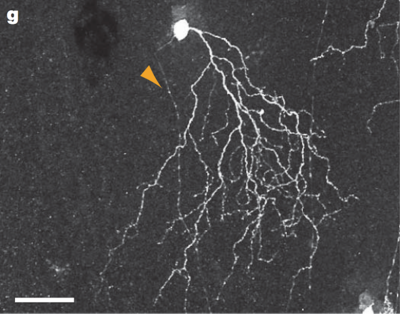J-RGC
JAM-B cells are a molecularly defined subcategory of retinal ganglion cell in mice which respond specifically to upward motion. 
Contents
Introduction
JAM-B cells are named after Junctional Adhesion Molecule B, the molecular marker first used to define them as a distinct subset of retinal ganglion cells. JAM-B share many traits in addition to the presence of this molecule. They are all OFF RGCs, with asymmetric dendritic arbors aligned in a dorsal-to-ventral direction across the retina (source: Kim et al.) Their deepest importance to the study and categorization of cells in the retina lies in that they were the first RGC to be classified using a molecular marker.
Anatomy
One of the most notable anatomical features of JAM-B cells is a marked asymmetry in their dendritic arbors. More than 90 percent of the dendritic arbor lies on one side of the soma. Asymmetry of the dendritic arbor is an unusual feature for a Retinal Ganglion Cell, as the dendrites of most Retinal Ganglion Cells are symmetrical.
Even more notable is that the asymmetrical dendrites of JAM-B cells all point in the same direction, about 13 degrees nasal of ventral.
The dendrites of JAM-B cells have been found to arborize in a narrow band between processes of dopaminergic and cholinergic amacrines (source kim et al.)
Physiology
It has been proposed that the asymmetry of a JAM-B cell's dendritic arbors is related to their direction selectivity.
Whereas the selectivity of other direction-selective RGCs depends on input from starburst amacrine cells, which themselves show directional responses, J-RGCs receive little input from these cells and thus must rely on other mechanisms. One possible mechanism is suggested by the finding that inhibitory synapses on some RGCs are concentrated at distal dendrites. Distal inhibition on the asymmetric dendrites of J-RGCs could account for their asymmetrically displaced surround. (Previous two sentences taken directly from Kim et al. paper)
The receptive field of J-RGCs is unusual in that the integrated strength of its ON surround exceeds that of the OFF centre. (Kim et al.) Studies imply that no sizable populations of OFF
RGCs exist with asymmetric dendrites pointing in directions other than dorsal-to-ventral (source: Kim et al.)
Kim et al. used yellow fluorescent protein to trace the projection of JAM-B cells to the mouse brain. They found that JAM-B cells project heavily to the superior colliculus. Thus it seems that mice have invested heavily in the detection of upward motion. It remains to be determined why exactly this is the case.
Molecules
JAM-B Cells are classified by the expression of the JAM-B protein.
Junctional adhesion molecule B is a protein that in humans is encoded by the JAM2 gene. JAM2 has also been designated as CD322 (cluster of differentiation 322). Tight junctions represent one mode of cell-to-cell adhesion in epithelial or endothelial cell sheets, forming continuous seals around cells and serving as a physical barrier to prevent solutes and water from passing freely through the paracellular space. The protein encoded by this immunoglobulin superfamily gene member is localized in the tight junctions between high endothelial cells. It acts as an adhesive ligand for interacting with a variety of immune cell types and may play a role in lymphocyte homing to secondary lymphoid organs. (source: Wikipedia)